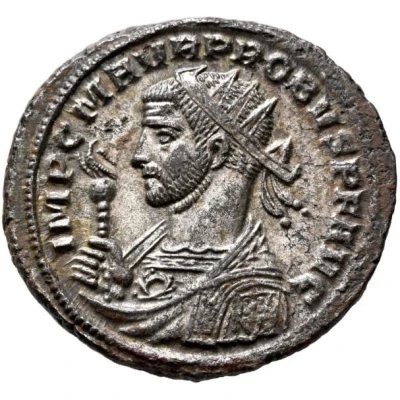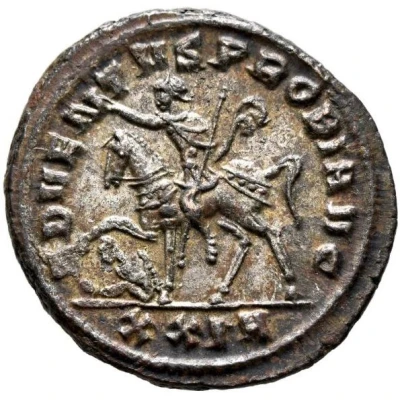


© Leu Numismatik
Antoninianus - Probus ADVENTVS PROBI AVG
| Silver | 3.2 g | 22 mm |
| Issuer | Rome › Roman Empire (27 BC - 395 AD) |
|---|---|
| Emperor | Probus (Marcus Aurelius Probus) (276-282) |
| Type | Standard circulation coin |
| Years | 276-282 |
| Value | Antoninianus (1) |
| Currency | Antoninianus, Reform of Caracalla (AD 215 – 301) |
| Composition | Silver |
| Weight | 3.2 g |
| Diameter | 22 mm |
| Shape | Round (irregular) |
| Technique | Hammered |
| Demonetized | Yes |
| Updated | 2024-10-05 |
| Numista | N#292988 |
|---|---|
| Rarity index | 94% |
Reverse
Probus, riding left, raising right hand and holding sceptre in left hand; under horse, captive.
Script: Latin
Lettering:
ADVENTVS PROBI AVG
-/-//XXIP
Translation:
Adventus Probi Augusti.
Adventus (Roman welcoming ceremony) of emperor (Augustus) Probus.
Comment
Mass varies: 2.46–4.47 g;Diameter varies: 21.84–23 mm;
Example of this type:
Münzkabinett der Universität Göttingen
Source:
Online Coins of the Roman Empire (OCRE)
Interesting fact
The Antoninianus - Probus coin was part of a series of coins issued during the reign of Emperor Probus (276-282 AD) to celebrate the Roman Empire's military victories and to promote the cult of the Roman emperors. The coin's design features the emperor's portrait on one side and various symbols and legends related to the military campaigns on the other side. This particular coin is made of silver and weighs 3.2 grams, which was a significant weight for a coin at that time. It's interesting to note that the coin's design and weight were carefully chosen to convey the power and prestige of the Roman Empire, and to promote the emperor's image as a strong and successful leader. The coin's silver content also made it a valuable and sought-after currency, both within the empire and beyond its borders. Overall, the Antoninianus - Probus coin is a fascinating piece of history that provides a glimpse into the economic, political, and cultural dynamics of the Roman Empire during the 3rd century AD.